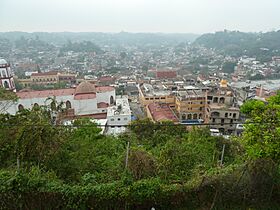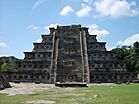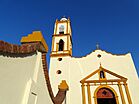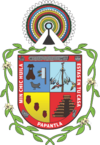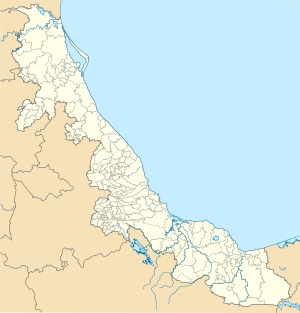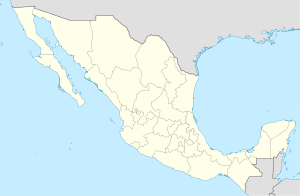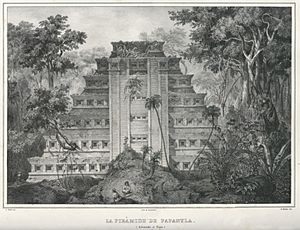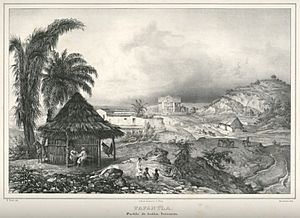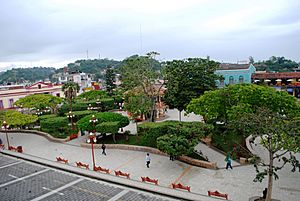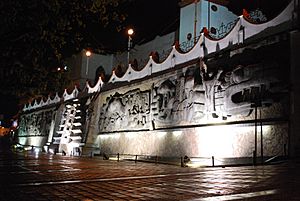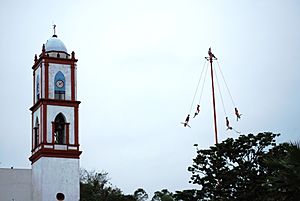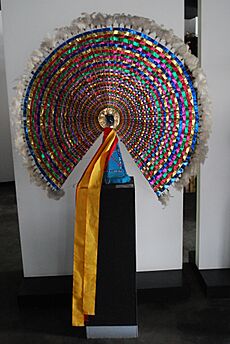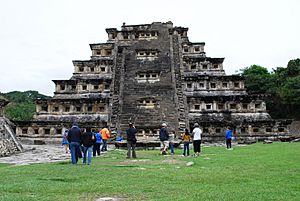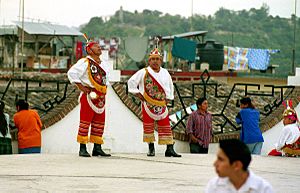Papantla facts for kids
Quick facts for kids
Papantla
|
||
|---|---|---|
|
City and municipality
|
||
| Papantla de Olarte | ||
|
Top: Panoramic view of Papantla's Downtown; Middle: Papantla Municipal Hall, Main Plaza; Bottom: El Tajín Archaeological Zone, Our Lady of the Assumption Church
|
||
|
||
| Country | ||
| State | Veracruz | |
| Founded | 13th century | |
| Municipal Status | 1880 | |
| Area | ||
| • Municipality | 1,458.5 km2 (563.1 sq mi) | |
| Elevation
(of seat)
|
180 m (590 ft) | |
| Population
(2020)
|
||
| • Municipality | 159,910 | |
| • Density | 109.6/km2 (284/sq mi) | |
| • Seat | 55,452 | |
| Time zone | UTC-6 (Central (US Central)) | |
| • Summer (DST) | UTC-5 (Central) | |
| Postal code (of seat) |
93400
|
|
| Demonym | papanteco | |
Papantla (Spanish: [paˈpantla]) is a city and a surrounding area (called a municipality) in the northern part of Veracruz, a state in Mexico. It's located in the Sierra Papanteca mountains, close to the Gulf of Mexico. The city was started in the 1200s by the Totonacs, an indigenous group. Since then, it has been an important center for the Totonacapan region.
Papantla is famous for a few things:
- Vanilla, which grows naturally here.
- The amazing Danza de los Voladores (Dance of the Flyers).
- The ancient El Tajín archaeological site, which is a World Heritage Site.
Many Totonac people still live in Papantla today. They keep their culture and language alive. The city also has many large murals and sculptures by a local artist named Teodoro Cano García. These artworks celebrate the Totonac culture. The name "Papantla" comes from the Nahuatl language. It means "place of the papanes," which are a type of crow. You can see this meaning on the municipality's coat of arms.
Contents
Papantla's History
The area around Papantla has been home to several ancient cultures. First were the Olmec people, followed by the Huastecs. You can find signs of these cultures at nearby archaeological sites like Cempoala and El Tajín.
The city of Papantla was founded around the year 1200. Different groups of Totonacs settled here. Some came after being pushed south by the Chichimecas. Others came from the ancient city of El Tajín after it declined. Before the Spanish arrived, Papantla was part of the Totonacapan region. It was controlled by Tuzapan and paid taxes to the powerful Aztec Empire.
Spanish Arrival and Vanilla Trade
After the Spanish conquest of the Aztec Empire, the Spanish quickly discovered how valuable vanilla was. Vanilla beans grow naturally in this area. The Totonac town was renamed Papantla de Santa María de la Asunción. Spanish families then moved into the area. Soon, vanilla was being sent all the way to Europe. Papantla became the main city for the Totonacapan region. This region included many modern towns like Cazones and Tecolutla.
In 1785, a Spaniard named Diego Ruiz accidentally found the ruins of the ancient city of El Tajín. He was actually looking for hidden tobacco farms. El Tajín became famous worldwide thanks to writers like Alexander von Humboldt.
Independence and Modern Times
During the Mexican War of Independence, a local hero named Serafin Olarte fought against the Spanish. He led his guerrilla fighters in the area from 1813 to 1820. Sadly, Olarte was captured and executed. In 1880, Papantla officially became a municipality. In 1910, it became a city and was named Papantla de Hidalgo. Later, its official name changed to Papantla de Olarte, honoring Serafin Olarte.
Before the Mexican Revolution, indigenous people in the area rebelled against the government in the late 1890s. Many battles were also fought here during the Mexican Revolution. In 1922, Papantla became the center of its own church district, called the Diocese of Papantla.
Teodoro Cano Garcia's Art
One of the most famous people from Papantla is the artist Teodoro Cano Garcia. He was a student of the famous Mexican painter Diego Rivera. For much of the 20th century, Teodoro Cano Garcia worked to promote Papantla's Totonac heritage. He created most of the sculptures and public artworks you see in the city today.
Some of his famous works include:
- The "Evolution of the Totonac Culture" mural on the side of the main church.
- The "History of Papantla" mural on the side of the Chapel of Cristo Rey.
- The Monumento del Volador, a giant statue on a hill in the city center.
In 2012, Papantla officially became a "Pueblo Mágico" (Magical Town). This is a special title given to towns in Mexico that have unique cultural or historical importance.
Exploring Papantla City
Papantla is the main city of the Totonacapan region. When the Spanish rebuilt the town, they designed it with a central plaza. Important buildings like the main church and government hall were built around this plaza.
Municipal Palace
The Municipal Palace, or city hall, still faces the main plaza. It has a classic-style front entrance. Inside, you can see two murals. One is about the Totonacs by Teodoro Cano Garcia. The other is by Xolotl Martinez Hurtado de Mendoza. The building was first built in 1810. It was destroyed in 1915 and rebuilt in 1929.
Israel C. Téllez Park
The main plaza is officially called the Israel C. Téllez Park. It has green grass and many trees. On weekends, the plaza comes alive with events. You can enjoy "Danzón Fridays," live music on Saturdays, and cultural events on Sundays. Underneath the park's bandstand, there's a mural by Teodoro Cano Garcia. It shows the Totonac idea of creation, with a world that has four suns.
Church of Nuestra Señora de la Asunción
The Church of Nuestra Señora de la Asunción was built between 1570 and 1590 by the Franciscans. At first, it didn't have a bell tower. The bell was on a nearby hill where the Monument al Volador is now. The bell tower was added in 1875, and the clock was put in place in 1895. The church has a cross shape and an entrance with Roman-style pillars.
Across from the church are the main markets, Hidalgo and Juarez. On the church's outer wall, there's a sculpted mural by Teodoro Cano Garcia. It shows the history of Totonac culture, blended with the image of the god Quetzalcoatl.
The city has a total of eleven murals on public and private buildings. The Fernando Gutierrez Barrios Auditorium has a mural showing sports in the Totonacapan region. The Chapel of Cristo Rey, on Madero Street, looks like the Notre Dame Cathedral in Paris. It has a mural by Cano about Papantla's history.
Monument to the Voladores
The Monument to the Voladores is on a hill in the city center. This hill is also a great viewpoint. It has a mural that tells the story of the Voladores ceremony. It shows everything from cutting the tree to the flyers descending.
Museums and Local Food
Papantla is home to the Universidad Pedagógica Veracruzana. It also has several museums:
- The Museo de la Ciudad (City Museum) has exhibits from ancient times, the colonial period, and after Mexico's independence.
- The Museo de las Mascaras (Mask Museum) has over 300 masks from Totonacapan and other parts of Mexico.
- The Teodoro Cano Garcia Museum displays works by the artist and his students. It also has ancient artifacts and Totonac cultural items.
Local food specialties include frijoles in alchuchut, tashuayahun, and zacahuil.
Festivals and Traditional Dances
Papantla has many vibrant celebrations and dances.
Dia del Niño Perdido
On December 7th, people celebrate the "Dia del Niño Perdido" (Day of the Lost Child). On this day, lighted candles are placed on windowsills and doorframes.
Corpus Christi Festival
The biggest festival in Papantla is the feast of Corpus Christi. This festival includes parades and traditional indigenous dances. Some of these dances are the tocotines, guaguas, negritos, Santiagueros, and voladores. The first Corpus Christi celebration in Papantla was held between 1550 and 1560.
Until recently, the celebration was mainly religious. But in 1957, a more public event called the Festival of Corpus Christi was added. This included a fair for livestock, agriculture, industry, and culture. In 1958, the "Juegos Florales" (flower arrangements) and the Xanath Festival were added. The Xanath Festival was started to show Totonac culture and make people proud of their heritage. It features indigenous art, traditional dance, costumes, and music.
Day of the Dead
Like the rest of Mexico, Papantla celebrates Day of the Dead. But it has its own local traditions. "Ofrendas" (altars for the dead) can be set up on tables or hung from the ceiling. These altars are called "pachau." Not having one can be seen as breaking community rules. They are decorated with palm leaves, bananas, oranges, limes, and chocolate figures. Foods like mole, candy, tamales, and local breads are placed on the altar. A glass of water and "renio" (a local alcoholic drink) are also included.
Day of the Dead celebrations start on October 31st for those who died naturally. On November 1st, the souls of children (called Laqsq’at’an) are welcomed. Later on November 1st and 2nd, the souls of adults are believed to return. People believe the souls come as insects to eat the food offered. This food needs to be freshly prepared and hot. At night, groups of children go house to house singing traditional songs.
Danza de los Voladores (Dance of the Flyers)
The Danza de los Voladores is one of Papantla's most important dances. According to Totonac myths, the gods told humans, "Dance, and we shall observe." This ceremony was originally meant to please the gods.
The ceremony involves five people who climb a tall pole, about thirty meters high. Four of them tie ropes around their waists. They wrap the other end of the ropes around the top of the pole. Then, they slowly descend to the ground. Each rope is wrapped around the pole thirteen times. Since there are four flyers, this makes 52 turns (4 x 13 = 52). This number matches the 52-year cycle of the Mesoamerican calendar.
The fifth person stays at the top of the pole. They play a flute and a small drum. The flute sounds like birdsong, and the drum is the voice of the gods. The four "flying men" represent the four main directions. The flutist starts by honoring the east, where life is believed to have begun. This dance is so special that UNESCO has recognized it as a Masterpiece of the Oral and Intangible Heritage of Humanity.
Dance of the Guaguas
The Dance of the Guaguas (also spelled Huahuas) is mostly performed by Totonacs. Some Nahuas and Huastecs in the area also perform it. This dance shows old beliefs about farming and the solar year. A key part of the dance is a wooden cross that spins vertically. This cross represents creation and the start of life.
Dancers wear red pants with detailed embroidery, white shirts, and a decorated cloth across their chests. But their most unique clothing is the headdress. It's a large circle of woven ribbons with loose ends hanging down their backs. The dancers stomp their boots as they move.
Vanilla: A Sweet History
Papantla is the heart of Mexico's vanilla-growing region, called Totonacapan. Vanilla has been grown and traded here since ancient times. According to legend, the Totonacs have grown vanilla since they came to this area. The story says that the vanilla plant came from the death of two young lovers. A beautiful princess named Tzacopantziza was dedicated to a goddess. But a young prince, Zkatan-Oxga, kidnapped her. The gods were angry and sent a monster. Priests found the couple and killed them. Where their blood spilled, a plant grew. This plant soon gave people fragrant flowers and vanilla pods.
True vanilla comes from the seed pod of an orchid called Vanilla planifolia. This plant grows like a vine on trees in this area. The pods are green when picked and turn black when dried. In the Totonac language, vanilla is called Xanath. It's used to make a special drink that's rarely found outside Papantla. The Totonac people have used vanilla for centuries to flavor food, make perfumes, and as medicine.
When the Spanish arrived, they quickly started sending vanilla to Europe. Many vanilla growers became very rich. The name "vanilla" comes from the Spanish word "vainilla," meaning "little seed pod." For a long time, Mexico was the only place where vanilla was grown. But then, people learned how to hand-pollinate the plant. This allowed vanilla to grow in other parts of the world. This hurt the vanilla industry in Mexico. Today, countries in Africa and Asia produce more vanilla than Mexico. However, in 1921, the Academy of Sciences and Gastronomic Arts in Paris honored the Totonacs for discovering vanilla.
Outside of Papantla, real vanilla is hard to find in Mexico because it's expensive. In the Papantla area, people make detailed figures, like animals, using vanilla pods. The Xanath Festival, held during Corpus Christi, also celebrates vanilla. Papantla also hosts a Vanilla Expo in December.
Papantla Municipality
| Historical population | ||
|---|---|---|
| Year | Pop. | ±% |
| 1995 | 171,167 | — |
| 2000 | 170,304 | −0.5% |
| 2005 | 152,863 | −10.2% |
| 2010 | 158,599 | +3.8% |
| 2015 | 161,097 | +1.6% |
| 2020 | 159,910 | −0.7% |
The city of Papantla is the main center for over 337 other communities. These communities cover a large area of 1,458.5 square kilometers. About one-third of the municipality's population of 159,910 (in 2020) lives in the city itself.
The city and municipality still have strong Totonac communities. About 25% of the people in the municipality speak an indigenous language. Most people identify as Catholic, but about ten percent are evangelical Christian. Papantla shares borders with other municipalities like Cazones de Herrera and Tecolutla. It also borders the state of Puebla to the south and the Gulf of Mexico to the east.
Geography and Nature
The municipality is in the Sierra Papanteca, which is a series of low mountains with many valleys. Some notable peaks include La Jarana and El Campanario. Small rivers like the Tlahuanapa and Santa Agueda flow through the area. These rivers feed into the Tecolutla and Texistepec Rivers.
The area has dense subtropical forests with trees like heliocarpus, laurel, cedar, and ceiba. It also has 17 kilometers of mostly untouched beaches. The coastline includes the Boquila Estuary and various beaches like Playa Chichinit. Most of the animals are small mammals like rabbits, raccoons, and coyotes. There are also many types of birds and snakes. The area is considered a tropical rainforest. Most rain falls between May and August. September and October sometimes bring hurricanes.
Economy and Tourism
About 75% of the municipality's land is used for farming and pastures. Around 47% of the people work in agriculture and crafts. Main crops include corn, beans, chili peppers, and oranges. Farmers also raise cattle, pigs, sheep, and horses. Some logging is done here. There is some industry, mostly packing and shipping oranges.
Tourism is becoming a big part of the economy. People visit for the ancient archaeological sites, beautiful beaches, and unique traditions. The Danza de los Voladores is a major attraction.
Archaeological Sites
The El Tajín archaeological zone was a major city in ancient Mesoamerica. It existed between 800 and 1150 C.E. The site covers 105,555 square meters and has 165 buildings and 17 ball courts. The most famous structure is the Pyramid of the Niches. There is also a museum at the site.
Every year, the Cumbre Tajin Festival takes place at El Tajín during the spring equinox. This festival celebrates Totonac heritage with concerts, talks, food, cultural events, and workshops.
Another archaeological zone is Cuyuxquihui. It covers about thirty hectares. It has various ancient structures, including a military fort and a ceremonial center. It is located about 37 kilometers from the city.
There are also two ecological parks called Kiwíkgolo and Xanath.
See also
 In Spanish: Papantla de Olarte para niños
In Spanish: Papantla de Olarte para niños


